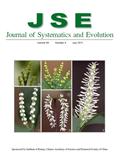Qiang ZHANG,Alexandre ANTONELLI,Taylor S. FEILD,Hong-Zhi KONG
Chloranthaceae is one of the earliest diverging angiosperm families and is comprised of approximately 75 species in four genera (Chloranthus, Sarcandra, Ascarina, and Hedyosmum). This family has received considerable attention because of its seemingly primitive morphology, disjunct tropical distribution in Asia and America, and extensive fossil record from the Early Cretaceous. In the present study, we reconstructed the phylogeny of Chloranthaceae based on a combined dataset of three plastid DNA regions and 56 species. We then estimated divergence times in the family using two relaxed molecular clock methods (BEAST and penalized likelihood). We focused on testing the influence of fossil taxa in calibrating the molecular phylogeny, and on assessing the current taxonomy of the family in light of the phylogenetic results. Our results indicate that most intrageneric divisions within Ascarina and Hedyosmum are not monophyletic. The results from the dating analysis suggest that the Hedyosmum-like fossil Asteropollis represents a stem lineage of Hedyosmum, as has been suggested previously from morphological analyses. In contrast, our results indicate that the Chloranthus-like fossil Chloranthistemon, previously suggested on morphological grounds to be a stem relative of Chloranthus, may, instead, belong to the branch leading to the clade Chloranthus+Sarcandra. The median crown ages of Chloranthus, Sarcandra, Ascarina, and Hedyosmum estimated in the BEAST analysis were 26.3, 9.5, 31.0 and 45.8 million years ago (Ma), respectively, whereas the divergence between Chloranthus and Sarcandra, the splitting of Ascarina with the former two genera, and Hedyosmum separating from the three genera were estimated to 63.8, 95.7 and 111.1 Ma. The present study sheds further light on the temporal evolution of Chloranthaceae and exemplifies how molecular dating analyses may be used to explore alternative phylogenetic placements of fossil taxa.

